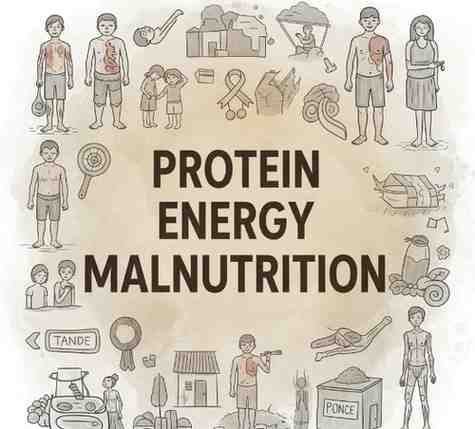
Your Account
Designed by Zeptt Technologies

PROTEIN ENERGY MALNUTRITION IN ADULTS & DIFFERENTIATION BETWEEN KWASHIORKOR AND MARASMUS
Protein Energy Malnutrition (PEM) is a pathological condition arising due to prolonged deficiency of proteins and calories in the diet.
Though more prevalent in children, it also affects adults, especially in cases of chronic illness, poverty, famine, eating disorders, and poor absorption.
DEFINITION
According to Modern Medicine: PEM refers to a spectrum of pathological conditions arising due to simultaneous deficiency of dietary protein and energy, frequently accompanied by infections.
According to Ayurveda: It can be correlated with Karshya (emaciation), Balakshaya (loss of strength), and Agnimandya (weak digestive fire), often classified under Apatarpana Janya Vyadhi (diseases due to undernutrition).
ETIOLOGY (NIDANA)
MODERN VIEW
Inadequate intake of protein and calories
Malabsorption syndromes
Chronic infections (e.g., TB, HIV)
Anorexia nervosa
Elderly with chewing/swallowing difficulty
Alcoholism
Famine, poverty, mental illness
AYURVEDIC VIEW
Mithya Ahara-Vihara – improper dietary and lifestyle habits
Agnimandya – diminished digestive capacity
Dhatukshaya – depletion of body tissues
Nidana like Shoka (grief), Krodha (anger), Ativyayama (excessive physical exertion)
Reference:
"अतियोगात् तपस्याश्च वायुर्दोषो विशेषतः।
शरीरं क्षपयेद्वेगो बलमूढीकरोति च॥"
— Charaka Samhita, Sutrasthana 28/21
PATHOGENESIS (SAMPRAPTI)
MODERN PATHOGENESIS
Prolonged deficiency leads to catabolism of fat and muscle tissue.
Loss of visceral protein stores causes hypoalbuminemia.
Immunodeficiency and delayed wound healing occur.
Leads to systemic derangements like edema, anemia, and organ dysfunction.
AYURVEDIC PATHOGENESIS
Deranged Agni → Impaired digestion → Improper Ahara Rasa
Poor formation of Rasa dhatu → Sequential Dhatukshaya
Leads to Karshya, Daurbalya, Shosha and Ojakshaya
Reference:
"सन्ततं ह्यल्पभोजित्वात् क्लेशात् चापि तथा मलात्।
रसादीनां क्षयं प्राप्तं, शरीरं लघुतां नयेत्॥"
— Ashtanga Hridaya, Sutrasthana 11/18
CLINICAL FEATURES (LAKSHANA)
GENERAL FEATURES IN ADULTS
Weight loss
Muscle wasting
Weakness and fatigue
Edema (in Kwashiorkor)
Poor wound healing
Skin and hair changes
Immunodeficiency and recurrent infections
Gastrointestinal disturbances
AYURVEDIC CORRELATION
Karshya – emaciation
Balakshaya – reduced strength
Alpagni – low digestive capacity
Shithilata – flaccidity
Daurbalya, Shrama, Shwasa, Atisara
TYPES OF PEM IN ADULTS
Marasmus – energy deficiency
Kwashiorkor – protein deficiency with relative calorie sufficiency
Marasmic-Kwashiorkor – combined form
DIFFERENCE BETWEEN KWASHIORKOR AND MARASMUS
| FEATURES | KWASHIORKOR | MARASMUS |
|---|---|---|
| Age group | >1 year | <1 year (or can affect adults too) |
| Cause | Protein deficiency | Calorie deficiency |
| Edema | Present (pitting, bilateral) | Absent |
| Muscle wasting | Masked by edema | Prominent |
| Fat stores | May be preserved | Depleted |
| Hair changes | Flag sign, depigmented, brittle | Thin, sparse hair |
| Skin changes | Flaky paint dermatitis | Dry, wrinkled skin |
| Appetite | Poor | Usually good |
| Mental status | Apathy, irritability | Alert or irritable |
| Immunity | Severely impaired | Impaired |
| Serum albumin | Low (<2.5 g/dl) | Normal or slightly low |
| Reference pathology text | Robbins Basic Pathology, Harsh Mohan | Robbins Basic Pathology, Harsh Mohan |
DIAGNOSTIC APPROACH
Anthropometric measures: BMI, MUAC, skinfold thickness
Blood tests: serum albumin, total protein, electrolytes
Clinical examination: edema, skin, muscle wasting
Dietary assessment
COMPLICATIONS
Hypoglycemia
Hypothermia
Infections (e.g., pneumonia, TB)
Electrolyte imbalance
Organ failure (liver, kidney)
Death if untreated
MANAGEMENT
MODERN MANAGEMENT
Correction of dehydration and electrolyte imbalance
Gradual nutritional rehabilitation
High-protein, energy-rich diet
Supplementation of vitamins and minerals
Treatment of infections
Psychosocial support
Referral in case of complications
AYURVEDIC MANAGEMENT
Brimhana chikitsa – nourishing therapy
Use of Balya, Rasayana, Agnideepana herbs
Yavagu, Mamsarasa, Ksheer, Ghrita based diet
Rasayana drugs like Ashwagandha, Shatavari, Pippali Rasayana
Panchakarma: Mridu Snehapana and Basti in chronic cases
Reference:
"बल्यं स्नेहकरं स्वादु स्निग्धं स्थैर्यकरं गुरु।
चिरस्थायी रसाद्यं च लघ्वन्नं मृदुपाचनम्॥"
— Charaka Samhita, Chikitsa Sthana 15/95
PROGNOSIS (SAPARYAYA)
Favorable if early diagnosed and managed.
Poor prognosis with complications like infections, electrolyte imbalance, or organ failure.
In Ayurveda, chronic Dhatukshaya may lead to Kashayata (cachexia) and poor prognosis if Ojas is depleted.
PREVENTION
Balanced diet with adequate calories and protein
Nutritional education and public health programs
Early diagnosis and prompt intervention
Ayurveda recommends seasonal Rasayana therapy and dietary discipline:
"रसादिभिः सदा तुष्टः संवर्धयति देहम्॥"
— Ashtanga Hridaya, Sutrasthana 3/28